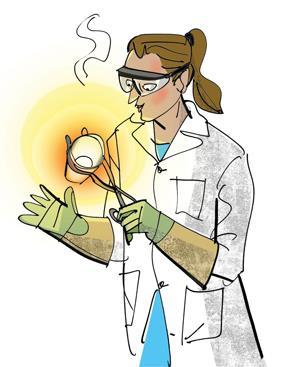Quality analysis is a very different ball game to a simple reaction check, says Chemjobber
Synthetic chemists are bedevilled by a simple question: which molecule should we make? In a chemical manufacturing environment, that question has already been answered. The most important questions for process chemists are qualitative: how shall we make this molecule? How can we do it safely?

Other questions are quantitative: how much does the customer want? How much are they willing to pay? When do they want it? There are short answers to these questions: too much; not enough; too soon. But there is always one question that becomes the guidepost: what is the desired quality? In other words, how good do they want it?
If the customer is a large corporation, there is nearly always a specification sheet. These documents look very official, with letterheads, stamps and signatures. They will usually answer the question in excruciating detail. If the corporation is wise, it will provide its analytical methods for judging the quality of the molecule. Chemists who receive such documents, as stringent as they may be, have good fortune on their side. Sometimes, even the customer does not know how good they want the product to be!
The tools that are the rod and staff of academic organic chemists, namely thin layer chromatography (TLC) and nuclear magnetic resonance (NMR) spectroscopy, do not make much of an appearance in customer specifications. TLC is rarely used, if ever. NMR specifications usually have the cursory statement ‘consistent with structure’. One imagines any graduate advisor would hardly accept such a statement. In my experience, infrared spectroscopy is more commonly used for identification than NMR.
When you pull the hot crucible out of the oven, you will hopefully find… nothing
While most people are familiar with ‘in-process checks’ for monitoring reactions, the tests required of products before they leave an industrial facility are less well known. The first test that a product commonly encounters is the simple loss-on-drying test.
After an organic compound is crystallised and isolated by filtration, the product is loaded into an industrial dryer and heated under vacuum to remove solvent. But how do we know when to remove the product from the dryer? Academic laboratories tend to measure to ‘constant weight’ (ie did the product’s weight stop changing?). Rather than asking operators to shovel out and weigh an entire dryer full of product, a representative sample is checked using a handy gadget called a moisture balance. This rapidly heats the product past the boiling point of the solvents that the material was crystallised from (hopefully not decomposing it). If the weight does not change (or at least not within a defined limit), the material is deemed dry and ready for further quality testing.
Whiter than white
There is always a purity component in specifications, expressed to at least two significant figures and a number that usually begins with a 9. Values between 99.5% and 98.0% are common, often expressed as a ‘greater than’ inequality. Now and again, you’ll see >95%, which is a pleasant surprise. On occasion, specifications will be even tighter, with demands for specific impurities at less than 0.1%. Analytical chemists will spend many an afternoon dissolving impurity standards, and preparing plant samples to be injected on gas chromatographs or high-performance liquid chromatography systems. Process chemists, in their turn, can spend nervous afternoons pacing in front of those instruments, waiting for purity data on a product fresh from the centrifuge or dryer.
Customers have varying levels of care towards the appearance of their molecules. The specifications can be as broad as ‘white to off-white to yellow to brown’. They may also be open to interpretation, but can be stretched too far. I once worked on a project where the customer said, upon delivery: ‘This material is too grey.’ Indeed, the compound was neither white nor off-white (and neither yellow nor brown), but a somewhat ashen hue. Redissolution and painstaking filtration provided product that was sufficiently white.
If the material is supposed to be coloured, there is often a quantitative measurement of the colour, as judged by its ultraviolet·visible absorbance at a specific wavelength. This cuts off any arguments like: ‘How yellow is yellow?’ or ‘Is this the right shade of blue?’
Ashes to ashes
A final, favourite specification test is the sulfated ash test to detect inorganic mineral salts. This is a teenager’s dream of what laboratory chemistry must be like. In a pre-weighed crucible, a known quantity of your hard-won product is utterly annihilated by concentrated sulfuric acid. With a propane torch, the product is reduced to billowing, papal clouds of toxic white sulfur dioxide fumes and black char. Hopefully, a working fume cupboard, a full-face respirator and a thick pair of gloves are protecting you from this.
Now that your organic compound has been carbonised, you can put it in a 750°C oven for 4 hours. This should burn up the carbon and leave any salts behind. If you’ve done sufficient water washes (or simply avoided introducing inorganic salts into your compound), when you pull the incredibly hot crucible out of the oven with a pair of tongs and carefully place it on the scale, you will find… nothing. Your product has been reduced to carbon dioxide and has been proven free of salts. With this last test completed, your product is finally ready to be shipped to the customer.
Chemjobber (@Chemjobber) is a process chemist and blogger based in the US












No comments yet